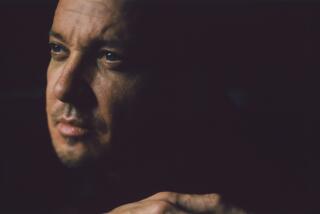Former Curator Regrets Not Quitting Earlier : Art: Muckenthaler museum’s ex-supervisor says he should have quit when first told to yank the Lennon photo. He and board chairwoman agree that blurred lines of authority led to the brouhaha.
Norman Lloyd, who resigned Thursday as curator at the Muckenthaler Cultural Center amid controversy over a nude photo of John Lennon, now says he should have quit when trustees first told him to take down the work.
And board chairwoman Beverly Gunter, who took responsibility for having the work removed from the exhibit in the first place, says if she could “turn back the clock” she would never have taken the action that precipitated Lloyd’s resignation.
Lloyd and Gunter, the two principals in the Muckenthaler brouhaha, agree that a failure to define the relationship between the curator and trustees in selecting art for exhibits touched off the events that thrust the city-run gallery into the national debate on art and censorship.
It is that blurring of lines between between professional staff and trustees at Muckenthaler that has alarmed arts professionals.
“I don’t think you can have an overreaction to a situation like that,” Hugh Davies, director of the La Jolla Museum of Contemporary Art, said Friday. “Whenever one institution is threatened with this kind of censorship, it threatens all institutions.”
The disputed photograph, by Annie Leibovitz, shows a nude Lennon curled in a fetal position and embracing his wife, Yoko Ono. It was removed before the show opened last week after several trustees who previewed the show objected to the photograph on the grounds that it portrayed Lennon as “weak” and thus did not fit the theme of the show, “Heroes, Heroines, Idols and Icons.”
After several days of controversy and intense media interest, Muckenthaler trustees voted Thursday night to restore the Lennon photo to the show, but Lloyd resigned minutes after the vote, saying the board had usurped his authority by first removing the photo, then voting to restore it.
Lloyd said that he accepted the initial demand to hold the work from the show until the full board of trustees voted on the issue. But that backfired, and he now acknowledges that he compromised his position as curator in the process.
“I didn’t realize the overall impact of letting these people at all into the decision-making process,” Lloyd said Friday. “I was hoping we could negotiate and get the work back in, but I should have stuck to my guns.”
Searching for direction, he called and spoke to several arts professionals during the week and said the verdict was unanimous: “They just said, ‘Realize the impact of what you’re doing,’ ” Lloyd recounted. “Whatever happens, it cannot imply that the board has the right to curate the show.”
Charles Desmarais, director of the Laguna Art Museum, was one person he called. Desmarais said he told Lloyd, “It’s our responsibility, those of us entrusted with museums and similar institutions, to be leaders. . . . We need to show leadership to our boards and stand for freedom of artistic expression.”
Desmarais said the controversy arose because the Muckenthaler does not have a clear policy delineating the responsibilities of staff and trustees. Desmarais added that he moved to define policy at his own museum soon after taking the director’s post in 1988.
At most arts institutions, according to Desmarais and Davies, the curator answers to the director and the director answers to the board, thus providing a cushion between staff and trustees. The trustees give general direction, set long-range policy and attend to the financial well-being of the institution.
“The day-to-day management of the institution is very much up to the staff,” Davies said.
“My trustees understand completely that the decision to display the works is entirely that of the curators and the professional staff,” Davies added.
Paul Schimmel, until recently the curator of the Newport Harbor Art Museum and now chief curator of the Museum of Contemporary Art in Los Angeles, said he sometimes wrangled with the board over artistic direction in his 10 years at Newport Harbor. But he said he was never pressured to remove a specific artwork.
At the Muckenthaler, Lloyd and center director Judith Peterson invited trustees to preview the show because they thought another Leibovitz photo, of artist Keith Haring, would stir controversy. There are mixed reports over the exact reason the trustees were called in. Lloyd says now it was merely a courtesy, but board chairwoman Gunter said at Thursday’s meeting that she had been asked to take part in the selection process. Peterson said the board’s role in viewing the work was left unclear.
“It would be sensible to warn trustees that sensitive material would be presented,” Davies said, but it is enough to give them advance notice, not to solicit their opinion or allow them to edit the exhibit.
Davies’ concerns were reflected by those of the artist.
“One of the troubling features of this situation is that the board took on itself to review and to alter the contents of the exhibition,” photographer Leibovitz said in a statement released Friday. “There is an increasing tendency for boards to interfere with the work of curators and artistic directors, and the boards’ decisions are almost always on the side of greater conformity.”
Gunter and Peterson both said setting policy at the Muckenthaler is the main goal for the board.
Leibovitz REACTION: Though happy the picture is back, the photographer says she’s still disturbed by the center’s earlier actions. F1
More to Read
The biggest entertainment stories
Get our big stories about Hollywood, film, television, music, arts, culture and more right in your inbox as soon as they publish.
You may occasionally receive promotional content from the Los Angeles Times.






